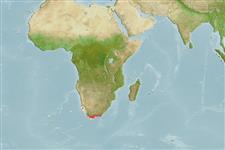Elasmobranchii (tubarões e raias) (sharks and rays) >
Carcharhiniformes (Ground sharks) >
Scyliorhinidae (Cat sharks) > Scyliorhininae
Etymology: Poroderma: poros (Gr.), hole or passage; derma (Gr.), skin or hide, allusion not explained nor evident (Smith proposed name without a description). (See ETYFish); africanum: -anum (L.), belonging to: Africa, described from South Africa. (See ETYFish).
More on author: Gmelin.
Environment: milieu / climate zone / depth range / distribution range
Ecologia
marinhas demersal; intervalo de profundidade 0 - 100 m (Ref. 5510). Subtropical; 28°S - 36°S
Southeast Atlantic: endemic to South Africa (Ref. 12484). There are old records from Madagascar and Mauritius, but these require confirmation (Ref. 244).
Length at first maturity / Tamanho / Peso / Idade
Maturity: Lm 68.5, range 65 - 72 cm
Max length : 101 cm TL macho/indeterminado; (Ref. 244); 93.0 cm TL (female)
Descrição breve
Chaves de identificação | Morfologia | Morfometria
Espinhos dorsais (total) : 0; Espinhos anais: 0. A large catshark with short nasal barbels and long horizontal black stripes (Ref. 5578).
Occurs in the continental shelf, both inshore and offshore (Ref. 5578). Prefers rocky reefs from the intertidal zone down to 100 m depth (Ref. 5578). Nocturnal, often found in caves and crevices during the day (Ref. 5578). Feeds mainly on crustaceans, but also bony fish and cephalopods (Ref. 244). Oviparous (Ref. 50449). Readily kept in captivity (Ref. 244).
Life cycle and mating behavior
Maturities | Reprodução | Spawnings | Egg(s) | Fecundities | Larvas
Oviparous, with a single egg-case per oviduct (Ref. 244). Embryos feed solely on yolk (Ref. 50449). Size at hatching between 14 and 15 cm.
Compagno, L.J.V., 1984. FAO Species Catalogue. Vol. 4. Sharks of the world. An annotated and illustrated catalogue of shark species known to date. Part 2 - Carcharhiniformes. FAO Fish. Synop. 125(4/2):251-655. Rome: FAO. (Ref. 244)
Categoria na Lista Vermelha da IUCN (Ref. 130435)
Ameaça para o homem
Harmless
Utilização humana
Pescarias: pescarias de subsistência; peixe desportivo: sim
Ferramentas
Relatórios especiais
Descarregue XML
Fontes da internet
Estimates based on models
Preferred temperature (Ref.
123201): 16.2 - 22, mean 19 °C (based on 20 cells).
Phylogenetic diversity index (Ref.
82804): PD
50 = 0.7500 [Uniqueness, from 0.5 = low to 2.0 = high].
Bayesian length-weight: a=0.00282 (0.00157 - 0.00504), b=3.22 (3.06 - 3.38), in cm total length, based on LWR estimates for this species & (Sub)family-body (Ref.
93245).
Nível Trófico (Ref.
69278): 3.6 ±0.5 se; based on diet studies.
Resiliência (Ref.
120179): Baixo, tempo mínimo de duplicação da população 4,5 - 14 anos (Fec assumed to be <100).
Fishing Vulnerability (Ref.
59153): High vulnerability (61 of 100).
Nutrients (Ref.
124155): Calcium = 20.9 [3.6, 115.7] mg/100g; Iron = 0.674 [0.178, 1.992] mg/100g; Protein = 18.3 [15.2, 21.4] %; Omega3 = 0.166 [0.072, 0.366] g/100g; Selenium = 22.6 [6.9, 64.6] μg/100g; VitaminA = 8.49 [2.90, 24.19] μg/100g; Zinc = 0.614 [0.294, 1.120] mg/100g (wet weight);
